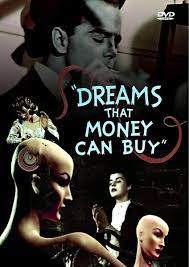
Joe (Jack Bittner) has managed get a lease on a room, but he has no job and no money to make his payments. While staring at his reflection in a mirror he realizes that he can see into himself. He reasons that if he can look into himself he can look into anyone. Joe understands that he can use this gift. He turns his room into an office. He sells dreams. Dreams specifically designed for each client based on their desires.
“Desire” His first client is Mr. and Mrs. A (Samuel Cohen, Ethel Beseda). Mrs. A wants her husband to have a dream “with practical values to widen his horizons”. Joe has her leave the room during Mr. A’s session. Mr. A is more artistically inclined. He wants a dream based on art images he shows Joe. Mr. A’s dream is based on a woman lying on a bed. It incorporates surreal images of two men fighting, the color red, iron bars and a voyeur looking in. A man wakens the woman. They stumble through a stone hallway together. The woman says, “Who wants to come with me, under my warm white gown”. Mr. A is pleased with his dream.
“The Girl with the Prefabricate Heart” A young woman comes in and tries to sign Joe up for various ridiculous organizations. That is her goal in life. Joe finally signs one and looks into her eyes. Her dream is in song form. Two mannequins have a marriage ceremony while voiceovers sing. Unfortunately, the marriage doesn’t work out since the girl mannequin has a prefabricated heart.
“Ruth, Roses and Revolvers” Mrs. A returns, not believing that Joe can really provide her a dream but wanting one anyway. Joe shows her a picture. Mrs. A says it looks like her when she was young. Her dream consists of a man and woman who, with others, watch a film and copy what the man in the film is doing.
“Discs” The next subject is a criminal. His dream consists of women descending a staircase naked but with blank discs blocking out their private parts. Then a drawing of what looks like a fish swimming in circles in a fishbowl. When he comes out of his dream the criminal robs Joe, knocks him unconscious, stuffs him in a closet and runs off.
“Circus” The next clients are a young girl and her blind grandfather. The girl plays with a ball as various mobiles slowing dance around. Joe comes to and reenters his office. The blind man says he doesn’t want to buy a dream but sell one. His dream is a circus of characters made from wire coat hangers. Joe buys his dream.
“Ballet” This dream is actually part of “Circus”, or the tail end of it. It is a wire ballerina dancing.
“Narcissus” When the next customer doesn’t enter the room Joe looks outside to see the next customer is himself. Joe takes a serious look at himself and the choices he made. His life as a nightmare.
“Dreams That Money Can Buy” was released in 1947. It is a color experimental film by Hans Richter. The film features works by various artists and displays them in an avant-garde and surrealist manner. It is a portmanteau of six vignettes.
They are not necessarily stories as much as dream sequences and as such they don’t necessarily follow a logical pattern but demonstrate symbolism in its most unorthodox form. What you see is what it is but what it is can be different to different people. The film is mostly told in voiceovers and song.
I never really thought about Dadaism or what it means. Most of the dreams were too abstract for me discover any real meaning from them. I did, however, like the vignette called “circus”. The wire characters were charming and detailed. Their antics were amusing, and I enjoyed their performance a lot. They didn’t seem to have any other meaning than what is seen, a pleasant caricature of circus figures as entertainment. Most people preferred the first vignette “Desire” as it portrayed the dream in a more surreal way and met people’s idea of what a dream should look like, especially an erotic one.
The film itself is rather minimalistic. Done on a shoestring the cost was supposedly around $25,000. The low budget is obvious in the sets and special effects. The color is a little faded in spots and the film stock a little worn. Of course, the minimalism could have been part of the overall intent of the movie. It did win the Venice Film Festival Award for the best original contribution to the progress of cinematography. Even so, this is not a film for everyone but meant more for those that like avant-garde and surrealism. Everybody else will just think it’s weird.
The sequences were written by 7 different artists. 1 “Desire” Max Ernst (Director/Writer). 2 “The Girl with the Prefabricated Heart” Fernand Léger (Director/Writer), Song Lyrics John Latouche Sung by Libby Holman and Josh White, accompanied by Norma Cazanjian and Doris Okerson. 3 “Ruth Roses and Revolvers” Man Ray (Director/Writer), Music by Darius Milhaud. 4 “Discs” Marcel Duchamp (Writer), Music by John Cage. 5” Circus” Alexander Calder (Writer), Music by David Diamond. 6 “Ballet” Alexander Calder (Director/Writer), Music by Paul Bowles. 7 “Narcissus” Hans Richter (Director/Writer), Music by Louis Applebaum Dialogue by Richard Holback and Hans Richter.

